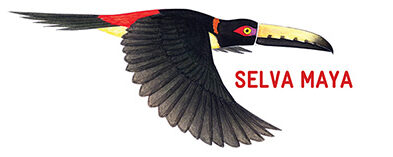
CONSERVATION
OF PROTECTED AREAS
COMMUNITY SURVEILANCE
To promote efforts that can replace a lack of institutional staff, particularly in areas considered “hot spots” due to the incidence of environmental crimes (hunting, extraction of flora and fauna, etc.), some protected areas in Mexico rely on local leadership immersed in zones of influence in the area. Since approximately 2010 and thanks to financial incentives from the Community Policing Program (PROVICOM) and the Temporary Employment Program (PET), the Bala’an K’aax Flora and Fauna Protection Area (APFF BK) has supported the establishment of community brigades that help this area achieve its goals of reducing threats through a Participatory Monitoring Program, strengthening both the quality and quantity of its participants.
In 2014 through the initiative of the protected area and the local communities involved, the Network of Community Surveilance “Muuch Kanan K’aax” (which in Maya means “together we take care of the forest”) was created. It involves eight groups of surveillance brigades monitoring the following ejidos (communal lands): Ejido Carolina (noted for being made up by women), Ejido San Francisco Sabana (with two groups), Ejido Candelaria II, Ejido San Isidro Poniente (with two groups), Ejido Ignacio M. Altamirano II, and Ejido San Felipe III and Ejido Venustiano Carranza. Altogether there are a total of approximately 70 brigadiers.
VOLUNTARY CONSERVATION
THE BELIZE CENTRAL CORRIDOR
The Belize Central Corridor (BCC) is made up mostly of private lands. It connects the two main protected blocks of forest in Belize: Rio Bravo to the north and the Maya Mountains to the south. The BCC has provided many of the communities within or around it with land for sustenance agriculture, hunting, construction materials and many other products. Its forests, especially those along the Belize River, have helped maintain the purity of the main water source of communities in and around the BCC: the Belize River Valley and Belize City. Regionally, the BCC is part of the Mesoamerican Biological Corridor that connects the Selva Maya with other forest areas. Because forests have been transformed or degraded, the BCC is becoming the crucial link between wildlife species that migrate and move between the two forest blocks with the long-term goal of maintaining healthy populations.
For more information go to: https://selvamaya.info/es/central-belize-corridor/
MONITORING
Given the premise of achieving the survival of the Selva Maya it is imperative to develop protection and adaptation measures. To do this, it is necessary to have reliable and comparable monitoring data that can help distinguishing changes in vegetation cover and species diversity in the region due to anthropogenic factors.
In Belize, Guatemala and Mexico there are several qualified institutions that investigate the impacts of climate change and socio-economic development on biodiversity. Monitoring results allow capture trends and provide guidance for implementing development plans and for management. Monitoring also makes it possible to assess the efficiency of conservation instruments in ensuring success in preserving biodiversity and measuring the impacts of climate change.
The next step is linking monitoring systems between the three countries of the Selva Maya to coordinate efforts and thus improve information, policies and management of natural areas.
